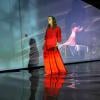
On the first-floor landing of the ornate United Theater on Broadway, a Butoh performer, in characteristic chalky white body makeup, carried a boulder of plaster-stiff fabric with painful slowness. The performer, Sindy Butz, was locked in with the Isaura String Quartet, droning and scraping away. Their unity was striking and strange, satisfyingly unsettling.
This was one of many concurrent “hauntings” occupying the lobby of the classic Spanish Gothic-style theater in downtown Los Angeles on Saturday evening, Oct. 19. The whole installation/immersive theater experience was called BARDO, in reference to the Tibetan Buddhist concept of a place where souls reside between death and rebirth.
Aside from that chilling Butoh performance, BARDO largely came across as a haunted mansion ride (with some NSFW moments thrown in). It suffered from an overall lack of clarity: Was this an attempt to disturb people or a fun display of Halloween kitsch? On one level of the lobby, feral kinky devils ripped up books and stapled the pages to each other, and on another level, there was a psychic with a top hat and a Party City crystal ball. Once the bulk of the audience had arrived, the experience was less experimental theater and more themed bar.

BARDO, created and directed by Sandra Powers, was the opening act for composer David T. Little’s Black Lodge, written for glam band Timur and the Dime Museum and produced by Beth Morrison Projects (BMP). The whole evening was presented by UCLA’s Center for the Art of Performance (CAP UCLA).
Black Lodge is described as “part film screening and part industrial rock opera concert,” and indeed, Timur’s band and the Isaura Quartet synced their performance with film on Saturday.
On paper, Black Lodge is an exciting aesthetic tangle of Beat writer William S. Burroughs, Theater of Cruelty theorist Antonin Artaud, and surrealist filmmaker David Lynch. This is a huge experiment in form, allowing for the darkness within the operatic tradition to cross with the psychosexual, death-obsessed inclinations of other artistic movements.
The productions championed by BMP are always worthwhile, but Black Lodge gets too much in its own way to really unsettle or disturb viewers as intended.
The film — directed by Michael Joseph McQuilken, who’s collaborated with the likes of Drake, Cardi B, and The Weeknd — is gorgeous. It stars lead singer Timur as the Man and the emotionally elastic performance artist Jennifer Harrison Newman as the Woman.

The loose “story” concerns a writer who is suspended in the realm between life and death, reliving the night he shot his partner in the head during a drunken, drug-addled game of Russian roulette. The tragedy is taken from the life of Burroughs, who purportedly shot his wife in the head at a party while performing what he called their “William Tell” act. The Woman puts a highball glass on her head as a target, as Burroughs’s wife is said to have done. In the film, the glass flickers interchangeably with a green apple.
Unfortunately, the operatic work is much more cohesive and effective in its album version, which was released in 2023. Listening to the recording after seeing the screening, I realized I would have preferred a showing without the live element altogether. The performances on the album and the effectiveness of the mix helped make the layers of Black Lodge more emotionally legible. Timur is an exceptional performer who has worked in the border space between opera and industrial rock, glam rock, and metal for some time, and though he endeavored to sell the music onstage, I found I was not watching him. The instrumentalists were split up and focused on staying in time with the film, which robbed their performance of electricity.
Following the film and parsing the supertitles took the majority of my attention. The libretto, by Anne Waldman, is dense. There is a lot of telling (rather than showing) in Timur’s part, and that robs the piece of its impact.
Little has an extensive oeuvre blending rock and metal with classical and operatic idioms, but the combination here didn’t deliver. More so than other rock genres, metal tends to spend more time on instrumentals than lyrics. Metal instrumentals, at their best, create a sense of physical disturbance in a listener, which the subject matter of Black Lodge calls for. But with so much text, the trappings of metal became a delivery system for the libretto. In other words, if you’re bringing metal, I’m not going to be happy until you to wake the fear of the devil in my heart with some truly heinous metrical modulations.
Despite incorporating horror elements throughout, the uncanny valley was nowhere to be found in Black Lodge. It was obvious that an amputated finger belonged to a mannequin. When the Man was stuck with pointed rods in some wicked medical procedure, there was neither blood nor a sense of threat.
Inundation with the surreal is not enough. Lynch terrifies us in the opening of his 1986 film Blue Velvet because, when Jeffrey Beaumont finds a severed ear in the grass on a normal walk home, everything else — the grass, the silence — is all too real. The odd choice Jeffrey makes to put the ear in a bag and take it to the police station is also real. The fundamental inscrutability of our normal-seeming protagonist is the source of the horror.

While the creators of Black Lodge are not claiming to reproduce Lynch’s brand of horror, they do literally reference Blue Velvet. There’s a whole song about finding a severed ear and even a portion of Lynch’s own writing in the libretto. But the adept balance between the familiar and the unfamiliar is lacking.
Lynch, Burroughs, Artaud, and metal all dredge the darkest places of the human psyche. With these influences in mind, I was expecting more than surface-level theatrics from Black Lodge.




